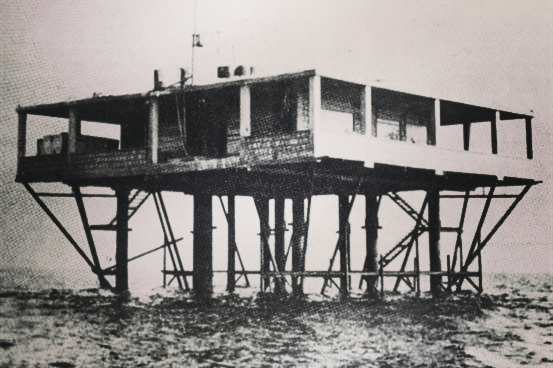Perhaps it’s not surprising that few people, up until recently, have heard of the small sovereign (though unrecognised internationally) state of the Isola delle Rose (Rose Island) – or to give it its official title, in esperanto, Insulo de la Rozoj. It’s foundation and eventual destruction – at the hands of Italian military engineers – took place in the hot summer of 1968, when student demonstrations shook Europe, and the Warsaw Pact prepared to smash violently the Prague Spring uprising.

It’s a fascinating story, though, and one that has been brought back into the limelight recently as divers from the Rimini scuba diving center Diveplanet have located the ruins of the ‘island’, about 11km off the coast of Rimini.
The story goes back to a Bolognese engineer named Giorgio Rosa, eager to experiment with structural design, but apparently fed up with Italian bureaucracy and red-tape – particularly in relation to building – came up with the bright idea of building a structure off the coast of Rimini that would be free of the rules and regulations.

The micronation Isola delle Rose, in 1968
After a number of years searching for the right site, building commenced and by 1967 the structure, a sea-platform, was opened to the public. Rosa had spent some time in dialogue with the Italian authorities in order to gain permission for the platform, but was blocked and told that in fact the site where the structure had been built was in Italian coastal waters (it was on the border of international waters, with only the south-westerly part actually in Italian territory) and part of a concession owned by Italian oil giant Eni.
In May of 1968 Rosa then took the extraordinary step of declaring the sea-platform an independent state, which would be a republic with its own currency, stamps, where the official state language would be esperanto. Rosa himself wasnt actively involved in the esperanto movement, but took up the suggestion of his friend the Bolognese priest Fr. Albino Ciccanti (whose profile you can find on the esperanto version of Wikipedia – Vikipedia). The self-declared state thus became officially Esperanta Respubliko de la Insulo de la Rozoj (The Esperanto Republic of Rose Island), with a President (Rosa), Finance Minister (Maria Alvergna), Minister for Internal Affairs (Carlo Chierici), and the Minister for Foreign Affairs (Cesarina Mezzini). The

The flag of the Rose Island
Despite the seriousness of Presidents, a council of ministers, and having their own stamps, money (the official currency of the island was to be the ‘Mill’, though no coinage was ever actually issued) and flag, the avowed intent of this motley crew was more simple – to set up a bar and trattoria on their self-built island, and enjoy the views of the Adriatic shipping lanes, sipping a beer as boats sailed by heading from Trieste in the North down to the Mediterranean.
For a short period the Island was a tourist attraction, with visitors flocking from the Riviera to sample a local taste of the spirit of ’68. It wasn’t to last long, though. On the 25th of June 1968, 55 days after its declaration of independence, the micronation of Rose Island was seized by Italian authorities in what Rosa bitterly declared ‘the only war that Italy has ever won’.

The Beatles in 1968
Throughout the rest of ’68, while the world’s attention was firmly focussed elsewhere (the Vietnam war, civil rights protests as far afield as the American South and Northern-Ireland, the smashing of the Prague Spring etc, the release of the Beatles White album etc), Rosa and his ‘government’ protested the seizure of the Island. Italian Parliamentary debates ensued where different theories emerged as to why the Island could not be allowed its continued existence.
The first theory, and the most obvious, was that the Island with its restaurant, nightclub, and souvenir shop was effectively Italian but avoiding Italian taxes – a dangerous precedent to set.

Josef Koudelka's famous image of Prague's Wenceslas Square, totally empty at noon on August 21, 1968, during the Warsaw Pact invasion of Czechoslovakia
The second theory came from the far-right parliamentary group MSI, who declared that the island posed a threat to NATO security, possibly offering cover etc to Soviet nuclear submarines (unlikely, given that Rosa himself was anything but left-wing, coming from a right-wing background and declaring himself to be above all a liberal).
The third theory, coming from the left-wing members of the parliament suggested that the island was, in fact, a platform to launch destabilising operations across the adriatic into Yugoslavia and Albania (in 1968 Albania was in the process of leaving the Warsaw pact).
As you can see, the dream of an escape from bureaucracy quickly became embroiled in international intrigue, and so on the 13th February of 1969 the Island was mined by Italian engineers crippling the platform, but not entirely destroying it. That would happen ten days later, when, during a storm the remains of the platform were submerged 1– sending the structure to the Adriatic seabed – where, now, in 2009 various dive expeditions are helping to bring back to the surface, metaphorically speaking, the independent island of the Rose.
Notes
1. “l 13 febbraio 1969 gli artificieri della Marina militare minano i piloni con 1.080 chili di dinamite. Le esplosioni piegano la piattaforma. Dieci giorni dopo, una tempesta fa inabissare l’Isola delle Rose.” – Riemerge l’isola dell’Utopia, Corriere della Sera 28/08/2009